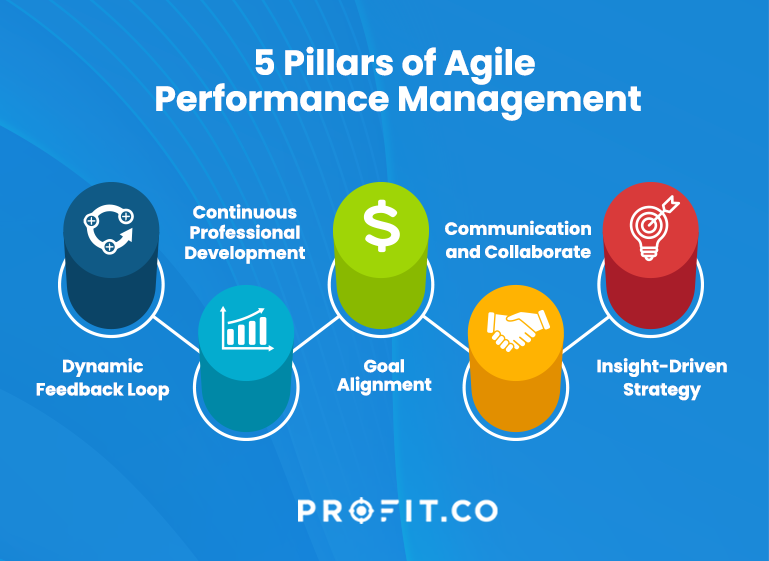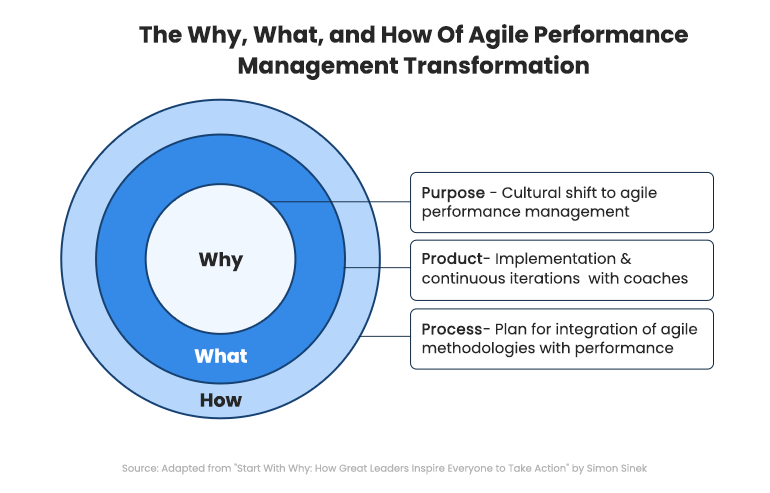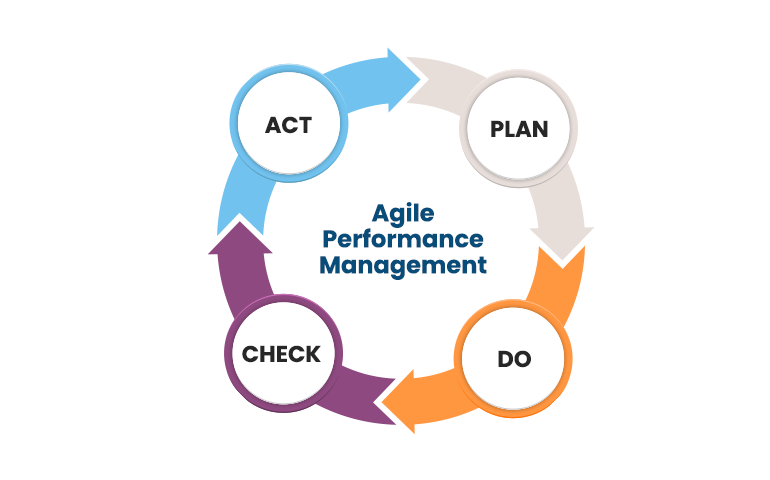Many of us have witnessed firsthand the struggle of shifting behaviors and methods toward a more agile state. It’s like trying to steer a giant ship with a small rudder; the effort is there, but the alignment is off. The root of the problem often lies in misaligned individual and team objectives, creating friction that slows down transformation efforts. It’s like pushing on a door marked “pull”—no matter how hard you try, you’re not going to get through until you change your approach.
The solution? A strategic partnership between leaders and HR to realign performance management system. By working together, we can create an environment that not only supports but accelerates transformation, reinforcing the behaviors that lead to agility.
Read on to uncover true agility through agile performance management.
“A manager is responsible for the application and performance of knowledge.”
What is Agile Performance Management?
Agile performance management is a breakaway from traditional organizations. As you might be most familiar with, instruction in a traditional organization comes from the top down. This is a tried-and-tested structure that clearly shows that the main governance body is at the top. However, it also makes the entire structure more rigid, and it takes longer to make major decisions, as instructions take a long time to verify as they pass through the chain of command.
Agile performance management on the other hand is not a new buzzword or a fleeting trend; we’re exploring a transformative approach that could redefine the success of your organization. Agile performance management goes beyond traditional metrics and yearly reviews; it’s about creating a culture that embraces change, rewards flexibility, and empowers teams to act decisively.
By focusing on the people within the teams and their development, rather than constantly being accountable to a higher authority, we allow employees to develop themselves. Thus, agile performance management allows quicker decision-making and adaptation in an unstable and constantly shifting environment. One key benefit, shown by the Harvard Business Review, is that employees who receive regular feedback are 4.6 times more likely to feel empowered to perform their best work.
Explore how Profit.co can aid your performance management
5 Pillars of Agile Performance Management
Below are the five core pillars of Agile Performance Management that transform traditional performance management into a dynamic, thriving culture.

1. Dynamic Feedback Loop
Within conventional organizational frameworks, performance management evaluations are typically sporadic, often annual events closely tied to fiscal incentives. Agile Performance Management, however, revolutionizes this process by instituting frequent and ongoing feedback mechanisms.
This progressive feedback is centered on an employee’s self-reflection regarding their work performance and their personal insights into potential enhancements to their professional journey. While performance metrics are still acknowledged, they are not the sole focus—priority is given to more holistic development aspects.
Managers in an agile environment are expected to arrange regular check-ins, weekly or bi-weekly—to maintain an intimate understanding of each team member’s contributions and challenges. This enables swift action and adjustments as needed. These check-ins occur both on an individual basis and within team settings.
The 360-degree feedback model is ideally suited for such an approach. It mandates that managers synthesize insights from the employee’s self-evaluations and their colleagues, cross-functional peers, leadership, and any other relevant sources. This comprehensive perspective equips managers with the necessary information to provide nuanced guidance for each employee’s skills enhancement and career growth.
2. Continuous Professional Development
Agile Performance Management (APM) fundamentals cultivate an environment where the growth mindset is deeply rooted and continuously flourishing. Far surpassing the outdated annual skill assessments, APM endorses a culture where professional development is an unending journey. It nurtures a climate that prioritizes the relentless advancement of skills and champions ceaseless knowledge acquisition. This steadfast dedication to professional growth guarantees that the workforce is not merely progressing in step with the ever-changing business landscape but is also driving the momentum forward.
3. Goal Alignment
It’s crucial to remember that even though a business is made up of different teams, everyone needs to be on the same page, working towards the company’s main goals. Managers have the task of making sure their teams’ work supports the big-picture objectives of the company. They do this by taking those big goals and breaking them down into smaller, individual tasks for each team member to tackle. This way, everyone’s daily work adds up and moves the whole team forward. These personal goals aren’t just handed down from above; they’re put together with input from each employee, who knows their own strengths and what they can handle.
4. Communicate & Collaborate
A pivotal element in the transition to agile performance management is establishing a culture where transparent communication is the norm. Prompt adaptability and responsiveness hinge on the assurance that employees are comfortable articulating their needs as they arise. Communication tears down walls between departments and encourages cross-functional teamwork. It creates a melting pot of ideas, perspectives, and skills where innovation thrives and problems are solved. Communication keeps the workforce engaged and willing to engage in dialogue with leadership. So, it’s up to the managers to create an environment where speaking up feels as easy as raising your hand.
5. Insight-Driven Strategy
This pillar is about leveraging analytics and insights to inform decision-making about having a panoramic view of performance metrics that can guide strategic planning. It’s about using data to track where you’ve been and spotlight where you’re headed, ensuring that every decision is underpinned by evidence and analysis.
APM, for example, empowers organizations to aggregate and analyze vast amounts of performance-related data from various sources—be it employee productivity tools, customer feedback channels, or operational efficiency metrics. This data aggregation provides a multidimensional view of organizational performance, revealing not just the outcomes but also the underlying drivers. By identifying patterns, trends, and anomalies within this data, leaders can pinpoint areas of strength to be leveraged and weaknesses that require intervention.
Together, these five pillars support a robust structure for Agile Performance Management. As organizations adopt these principles, they’ll find themselves not just moving with the times but moving ahead, crafting a workforce that’s equipped, empowered, and eager to meet the future head-on.
Perks of Shifting to Agile Performance Management
- Better Performance: Teams work better because they get feedback when it counts, not months later.
- Faster Response: When things change, the team can pivot quickly, not waiting for the annual review to determine the situation.
- Sharper Skills: Everyone gets to focus on what they’re best at, leading to a team of specialists.
- Happier Employees: Regular, meaningful chats about work make a happier workplace.
- More Data: Managers get a clearer picture with up-to-date info on how the team’s doing.
- Adaptable Structure: The whole organization gets nimbler and able to bend without breaking.
Switching to an agile system has benefits but takes time and effort. Rush it, and you might end up with a wonky setup where the team’s efforts are all over the place, and nobody’s sure who’s doing what.
Implementation
For organizations looking to make this strategic pivot, the journey begins with securing the initial buy-in from stakeholders for implementing Agile Performance Management (APM). This critical first step lays the foundation for a transformative process that promises enhanced performance, rapid value delivery, and a dynamic work culture.
1. Securing Stakeholder Buy-In
At the heart of any successful APM adoption is securing stakeholder buy-in. This requires a clear articulation of the “why” behind the shift, drawing on Simon Sinek’s Golden Circle model, as outlined in “Start With Why.” The journey towards agile transformation demands that leaders not only advocate for change but also inspire action through a compelling narrative that resonates with the organization’s core objectives.

With stakeholder support secured, the focus shifts to the “what” and “how” of implementing Agile Performance Management.
2. Cultivating an Agile Performance Culture
- To successfully transition, it’s crucial for strategic portfolio leaders to work closely with Human Resources (HR) to ensure that the systems for performance management and rewards are in sync for both leadership and team members, thereby boosting the adoption rate. Empowering agile teams by trusting them to make informed decisions and take ownership of their goals and outcomes is crucial. This empowerment fosters accountability and trust, which are indispensable for agile success.
- Creating an environment where people feel comfortable speaking up, exchanging ideas, and expressing their opinions is vital. Psychological safety, a top predictor of high-performing teams, encourages a culture of open dialogue and mutual respect, where mistakes are seen as learning opportunities.
- Encourage teams to adopt an experimental mindset to solve complex delivery and customer challenges. Leaders should promote the breakdown of work into small experiments, adjust plans based on customer feedback, and take calculated risks to foster innovation.
- Implementing retrospectives to identify process improvements and establishing communities of practice are essential for continuous learning and development. This ensures the organization is always advancing its technical skills and methodologies.
3. Balancing Autonomy and Control
- Adapting governance to support agile Performance management transformation means moving away from centralized, rigid control to a more flexible, continuous agile governance model. Try setting it up with one team first. Draw a clear roadmap. Give them a trial period so that you may measure any positive change.
- Leaders should collaborate with their HR counterparts to transition individual performance indicators towards skills and competencies rooted in agile methodologies. Additionally, incorporating team performance metrics into evaluating individual contributions should also be a key part of this strategy.
- For a transformation to be successful, setting new goals and long-term rewards might be beneficial. This approach enables leaders to concentrate on achieving a long-term vision, avoiding the pitfalls of short-term targets that could obstruct the shift in organizational behavior. By establishing broad goals and outcomes that can be broken down into team-specific objectives, leadership ensures that every member is responsible for contributing to the overall success and value delivery of the organization.
4. Implementing Agile Performance Management (APM) guided by the “plan-do-check-act” cycle
This cycle is the heartbeat of APM, driving continuous improvement and embedding agile principles deeply within the organization’s culture, processes, and behaviors. This iterative cycle ensures that APM is not just implemented but is continually refined and adapted, making agile performance management a sustainable part of your organization’s DNA.

5. Leveraging Agile Coaching for Effective Implementation
The role of agile coaches is invaluable in guiding and accelerating the APM implementation process. These experts bring a wealth of knowledge and experience, offering targeted advice and support at every level of the organization:
- These coaches focus on the tactical aspects of agile implementation at the team level, ensuring that agile practices are correctly adopted and effectively utilized.
- Operating at a broader scope, agile coaches help teams, departments, and programs integrate agile methodologies, aligning daily practices with the overarching goals of APM.
- At the strategic level, these coaches assist leadership in designing and executing a comprehensive APM transformation roadmap, ensuring that agile principles are woven into the fabric of the organization’s culture and strategy.
Their expertise helps in navigating the complexities of transformation, avoiding common pitfalls, and firmly establishing agile performance management practices that drive organizational success.
6. Use digital tools for Agile Performance Management
- Digital tools streamline agile performance management by automating routine tasks and processes, significantly reducing manual paperwork and administrative overhead, and freeing HR teams to focus on strategic initiatives.
- The software provides a unified platform for efficiently gathering feedback from a diverse array of sources, including colleagues, peers, and clients, facilitating a comprehensive view of employee performance.
- Utilizing data analytics capabilities, digital tools help identify patterns and trends in performance, offering valuable insights for pinpointing areas in need of support or development opportunities.
- Shared dashboards and online platforms ensure transparency, granting all employees access to view their progress and that of their team, encouraging open communication and collaboration and promoting ownership of personal development.
- Unlike traditional annual reviews, the software supports ongoing monitoring and evaluation of goals, allowing for swift adjustments in response to changing priorities or organizational needs, and ensuring alignment with current objectives.
7. Review the process
- After the test period, assess the team’s performance, identifying any improvements or shifts in productivity, efficiency, or other relevant performance metrics.
- Determine which specific changes or aspects of the new approach to agile performance management contributed most significantly to the observed performance changes.
- Use the insights gained from the analysis to refine and enhance the agile performance management practices, addressing any areas of concern or opportunities for further improvement.
- With the refined approach, replicate the process with other teams within the organization, applying the lessons learned from the initial test period to facilitate a smoother implementation and optimize outcomes across the board.
- Repeat the cycle, continuously seeking feedback and making adjustments to ensure ongoing improvement and scalability of agile performance management practices throughout the organization.
These steps can help you incorporate agile performance management into your business while mitigating any chaos a culture change might bring.
Conclusion
Agile performance management supported by performance management software is a fantastic style of management for the modern business world, where disruption and uncertainty are common. It improves how your employees work and encourages them to think out-of-the-box methods. The most essential point to remember is that employees play a central role here and that their increased engagement is essential to gaining all the benefits of agile performance management.
Check out the different tools Profit.co offers!
Related Articles
-
How to Streamline Compliance Management and Stay Ahead with Profit.co
Regulatory landscapes constantly change and evolve to keep up with technological advances and market demands. This volatility makes it challenging... Read more
-
How to Build and Use Tiger Teams to Tackle Complex Business Challenges
Even the most agile and goal-focused companies face obstacles and complex challenges. When these problems become mission-critical and require rapid,... Read more
-
The 70/30 Split That High-Performing Teams Swear By
Senthil Rajagopalan President & COO at Profit.co Last updated: March 7, 2025 When it comes to evaluating performance, we often... Read more
-
Why Department Heads Deserve Their Own Review Process
Arun Rajah Manager, Customer Success Operations Last updated: March 7, 2025 You wouldn’t review a coach the same way you’d... Read more

